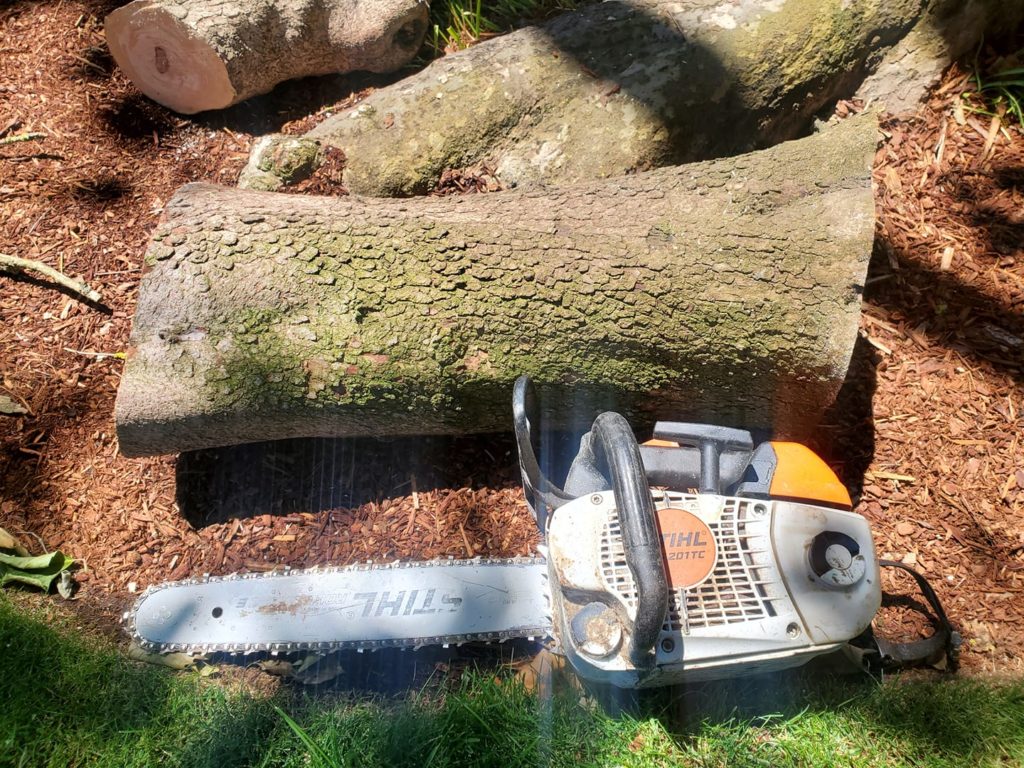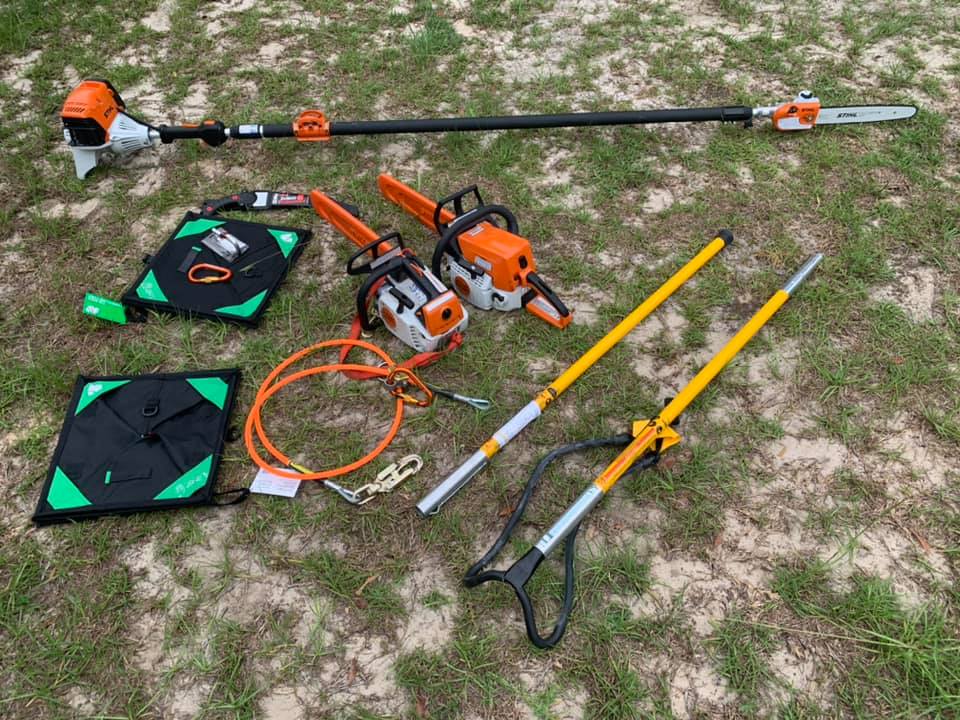This excerpt has been taken from “The pruning book” by “Lee Reich”. Chain saws are a portable, mechanical saw which cuts with a set of teeth attached to a rotating chain that runs along a guide bar. “Tree trimming Service Stockton CA” furnishes detailed info on these saws.
If more cutting power is needed than looping shears can provide, I always run to the shed and grab a pruning saw. Saws are the next step up in necessary tools as you progress to thicker wood. Do not try to use a saw from your woodworking shop to remove a limb because such a saw works effectively only on dry wood. The teeth on pruning saws are designed to cope with green wood without clogging or gumming.

Small handsaws come in many style, but trying to spell out what is best is akin to trying to say what brand or style of beer tastes best. That said, all good handsaws start with the highest-quality blades, variously referred to as turbo, Japanese, tri-edge, or three-angled. These blades have teeth with three bevels, which in turn, translate into fast smooth cutting. The fast cutting is for our benefit; the smooth cutting is for the plants because clean cuts mean less likelihood of diseases taking hold in wounds left from pruning cuts .To keep the blade from binding in the saw cut, alternate teeth on these saws are given a Slight bend outward in opposite directions, or the flat of the blade is ground thinner. The result in either case is that the teeth open a lit that has plenty of room in which the flat of the blade can slide easily without binding.
All those keen edges are for naught if the teeth won’t hold their edges, so the best saws’ blades also are forged from hardened steel. Then they’re plated to resist sap and rust. These saws generally cut on the pull stoke only, with saws having coarser teeth cutting faster but being slower to get started (a problem solved, perhaps with some sacrifice of cutting speed, in some silky brand saws having finer teeth toward their tips).
From here on, what makes a saw best gets more personal. For starters, these saws come with either straight or curved blades—the ones with curved blades are sometimes called “Grecian” pruning saws. Curved blades theoretically cut more easily, clenching the wood as they are pulled, but I find that difference negligible among saws having top-quality blades and good handles. Depending on the shape of the handle, a saw will be more or less compact and easier to work. It’s easiest to push and pull when gripping a handle that’s perpendicular to that motion, but such saws are bulkier to carry. Handles run the gamut from those almost in line with the blade to those whose pistol grips are closer to perpendicular to the motion of the saw. I like the rubbery handles, hooked at their ends to grip my hand even more securely, and the bright, easy-to-find colors of ARS and silky brand saws, but it’s a good idea to hold some saws yourself to see what you like before buying. I don’t want to even consider the possibility of a folding saw’s blade closing on my fingers as ‘push the saw forward, which makes me thankful for the positive-locking open leavers on lee valley, Bahco, ARS, and silky saws. Equally welcome is the release lever that prevents a sheathed saw from accidentally sliding out of its sheath.
Heavier/bladed, straight/bladed pruning saws look much like carpenter’s saws but with different sets of dentures. Avoid those that are reversible, having a row of coarse teeth on one edge of the blade and narrow teeth on the other. Such saws inevitable make unwanted cuts on wood near the side of the blade that you are not using! Purchase two separate saws instead.
Bow saw
A bow saw is a kind of pruning saw comprised of a sharp, quick-cutting, inexpensive, replaceable thin blade pulled taut between the ends of a similarly inexpensive bow of metal tubing. That bow, however, does keep this saw form getting into tight spaces.
Narrow-bladed saw
A handsaw with a narrow blade can insinuate itself into tight spots, and this is the kind of saw that I tend to use the most, making short work of branches up to about 3 in thick. These saws stuck neatly into sheaths or fold back into their handles, making them convenient to grab when going out in spring to prune your small trees or neglected lilac or forsythia bushes. The smallest of these saws are small and light enough to carry along for any early season stroll through the yard for corrective cuts here and there on any trees and shrubs.
Pole Saw
A pole saw which at its most basic is nothing more than a handsaw on the end of a pole, is for cutting limbs even higher than 15ft. With your feet planted on Terra firma. Using a pole pruner has never been one of my pleasures, but newer designs make up for some of the lack of control and inevitable crick in the neck attendant with these saws. The best have blades with similar high quality to those on the best handsaws. In addition, some blades come with hooked ends, useful for keeping the blade from slipping out of the cut and for pulling down any branches that remain hung up in the tree.
When assessing the quality of a pole saw, look also to the pole itself. My old pole saw had two telescoping fiberglass sections that, when extended, would flex under its own weight. That’s fine behavior for a fishing pole but makes control hard when pruning. Poles of the best of the contemporary pole pruners, such as those made by silky and ARS, are smooth-sliding, quick-locking, lightweight, and relative rigid aluminium. The rigidity is also the result of these poles’ oval, rather than round, cross sections. Fiberglass has the advantage of not conducting electricity should you happen to foolishly bump into an electrical wire, but the handles on aluminum-poled pruners are also non-conductive materials.
Chain saws
We cannot leave the subject of pruning saws without mention of the chainsaw. These gasoline or electric saws make relatively short work of large limbs—even whole trees (but that can hardly be called “pruning”) A chainsaw is overkill where you have only a backyard full of plants to prune; depending on your enthusiasm, a bow saw can almost match a chainsaw in its applicability, except it’ll do the job quietly and without the potential excitement of gashing your leg. Experience with chainsaws breeds respect for this useful, albeit dangerous, pruning tool. If the size of a cut dictates the need for such a tool, rent one for the job, or even better, hire a professional with a chainsaw to do the job for you. If you feel the need to own a chainsaw, purchase one scaled to the thickness of wood you will be cutting. And when you make your purchase, also buy a pair of goggles and, along with a gasoline-powered saw, a set of ear protectors.

Pole chain saws
Put a chainsaw on the end of a pole and you have a tool that is useful and not as unwieldy as it sounds. The use is the same as for a hand pole saw except, of course, the chainsaw is quicker but not as finely controlled. Pole chainsaws are less unwieldy than you might imagine because the saw is relatively small, it’s electric, and/or the motor or engine is down at the handle. Like the chainsaw itself, a pole chainsaw might be overkill for the average backyard full of trees.
Continue reading on Conifers in the garden
